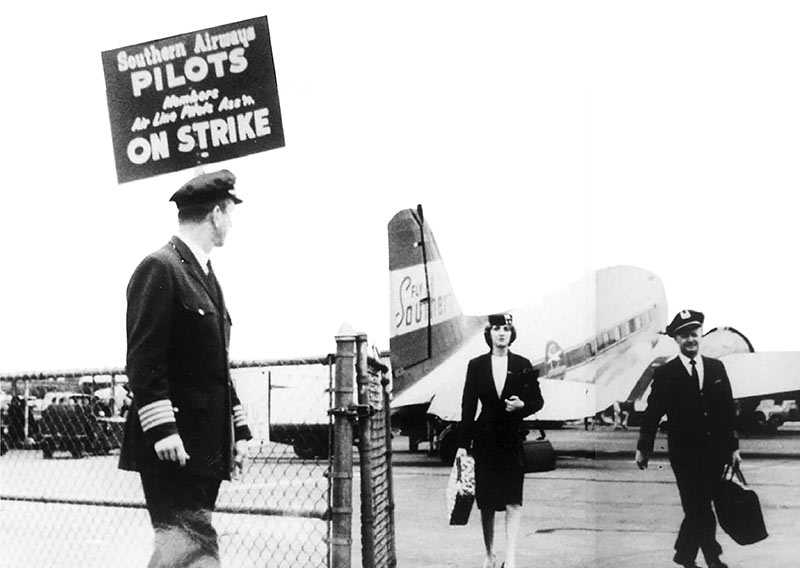‘The Southern Airways Strike of 1960’
90 Years of Flying the Line
By Christopher Freeze, Senior Aviation Technical Writer

This year marks the 90th anniversary of ALPA’s founding, when 24 “Key Men” pledged themselves to a higher purpose, bettering the working conditions and compensation of their fellow airline pilots.
Air Line Pilot has been highlighting chapters from Flying the Line, the Association’s unofficial history written by George Hopkins, that chronicle ALPA’s founding and the early days of airline flying. Why? To remind or inform members/readers that hard-earned gains in safety didn’t happen by accident, that the “safest place on the earth” isn’t an empty motto, and that ALPA has paved the way for 90 years to advance the airline piloting profession to where it is today.
The following is excerpted from the book’s 18th chapter titled “The Southern Airways Strike of 1960.”
Frank Hulse, president and founder of Southern Airways, wanted nothing to do with labor unions but had to as his various enterprises did a lot of work for the federal government. But whenever possible, he made life miserable for union members. In 1958, he broke the mechanics’ union on his airline after a wildcat strike.
Hulse got a certificate to operate an airline from the government late in World War II, but he did nothing with it until 1949. He leveraged the surplus of pilots to pay low wages. But several pilots, who had worked previously at American Airlines, began talking up a union, got an election, and voted for ALPA. All of these pilots were later fired.
In early 1959, the 140 Southern Airways pilots figured they were in trouble, as ALPA was now the last labor union at Southern. The fundamental issue at stake was equal pay for equal work, as ALPA had always insisted on the principle that the pilots of every airline, big or little, deserved the same pay for flying the same equipment. The smaller airlines never reconciled themselves to this idea, and from their beginning in the 1940s the new “feeders” paid substandard wages—at least until ALPA began to organize their pilots in the 1950s.
The eventual wearing out of the hand-me-down DC-3s in the mid-1950s led to regionals replacing them with modern equipment like Martin and Convair twin-engine aircraft, requiring heavy financial outlays. ALPA’s wage policy on the majors, which already operated the new equipment the regionals would soon need to acquire, would make pilot compensation an even larger expense if ALPA could negotiate comparable scales.
For nearly a year, from July 30, 1959, when the agreement with Southern Airways’ pilots came up for renewal, until June 5, 1960, when the strike began, the pilots were in almost continuous negotiations and mediation, constantly hitting a brick wall. Hulse believed that when push came to shove, his pilots wouldn’t walk out. When the pilots notified the company that they were left with no alternative but to “withdraw from service”—to use the phraseology of the Railway Labor Act—the airline’s management moved immediately to hire strikebreaking replacements.
The strike broke out at a bad time for ALPA. A dispute with the flight engineers’ union was in full swing, and the major airlines were gearing up to resist ALPA under their Mutual Aid Pact, which stated they would support each other financially during a strike. The Association’s financial support of the Southern Airways’ striking pilots was heavy enough to exacerbate other problems—especially when ALPA conducted an absolutely unique experiment in the annals of modern labor disputes: operating a rival airline.
The ALPA-sponsored Superior Airlines operated eight-passenger de Havilland Doves in direct competition with Southern Airways’ most profitable routes and departure times. It capitalized on public apprehension about Hulse’s strikebreakers, something that was much in the news by March 1961, owing to a high-profile case of a wholly unqualified man working as a commercial pilot and a couple of nonfatal accidents involving strikebreakers. Superior Airlines offered free champagne and personal service to keep ALPA’s case before the public, and nearly all of Superior’s employees, whether they were driving baggage trucks or taking tickets, were striking pilots….
More Flying the Line
As 2021 comes to close, we hope you’ll continue to either read Flying the Line, Vols. 1 and 2 or listen on Apple Podcasts, Spotify, and Podbean. Podcasts of Flying the Line, Vol. 2 will be available in 2022.

